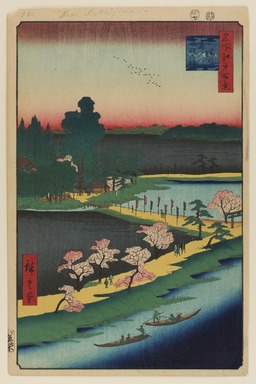
Artist:Utagawa Hiroshige
Medium: Woodblock print
Geograhical Locations:
Dates:7th month of 1857
Dimensions: Image: 13 3/8 x 8 3/4 in. (34 x 22.2 cm) Sheet: 14 5/16 x 9 5/16 in. (36.4 x 23.7 cm)
Collections:
Exhibitions:
Accession Number: 30.1478.31
Image: 30.1478.31_PS20.jpg,
Catalogue Description: Two boats pass each other on the North Jukkengawa Canal in the late afternoon sun. Between the shrine pennants are the darkened rice paddies on the left and a lotus pond on the right. Across the small bridge are the precincts of Azuma Shrine where a group of people are looking up at the giant split trunk of the sacred tree, known as the "Entwined Camphor" (Renri no kusu). Beyond to the left stand the shrine buildings. The legend of the "Entwined Camphor" goes back to Prince Yamato Takeru's journey to conquer the barbarians and wishing to cross the straits across the entrance to Edo Bay, where he was confronted by the angry god of the sea, his consort, Princess Ototachibana sacrificed herself to the sea to calm the waves and the prince was able to continue on his mission. Days later, the princess' comb washed up on the beach and was enshrined here in a small burial mound. The prince took a pair of camphor chop-sticks and buried them in the mound and they grew together into the paired tree seen here split into male and female trunks above. The prince gave the name, Azuma, for this place (Ao tsuma) and hence became a conventional term for this area of Japan. The entwined camphor survived until World War II when it was destroyed in a fire-bombing. Recently, a new pair was planted, apparently, in the hope that they might grow together as one, as before.